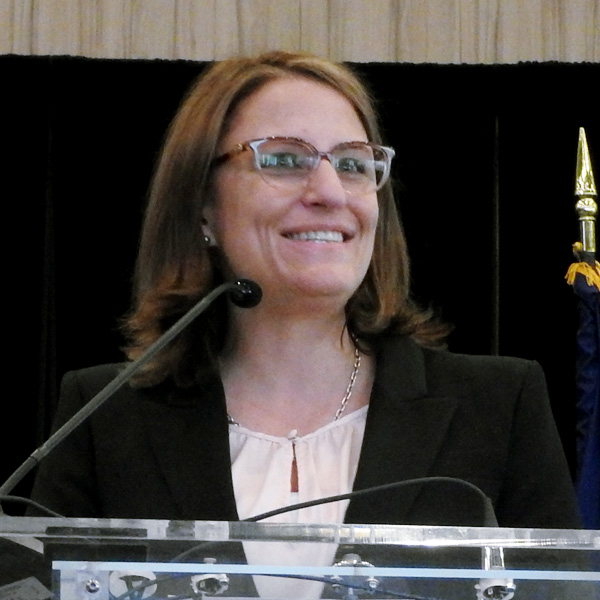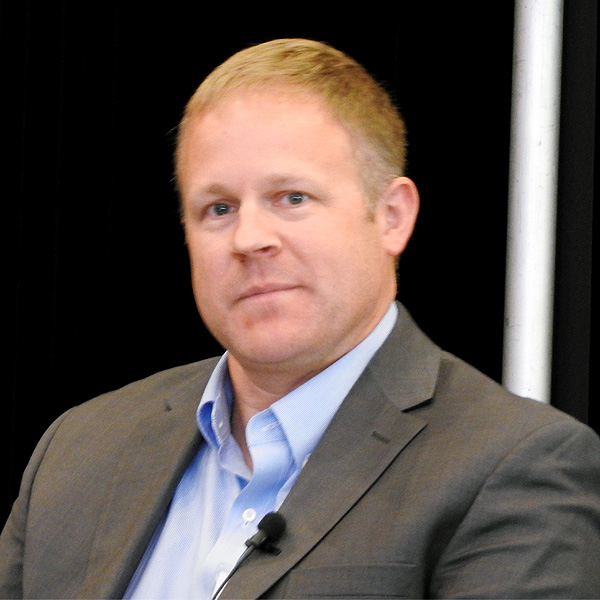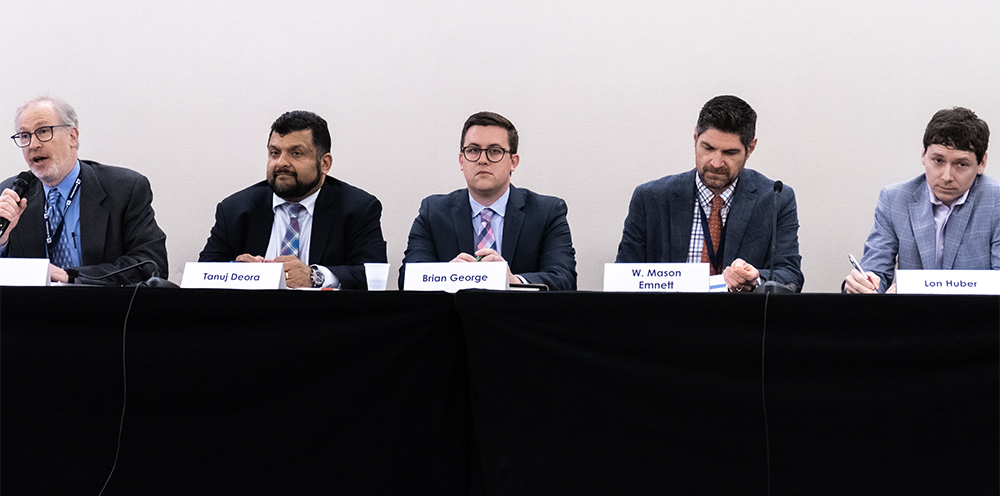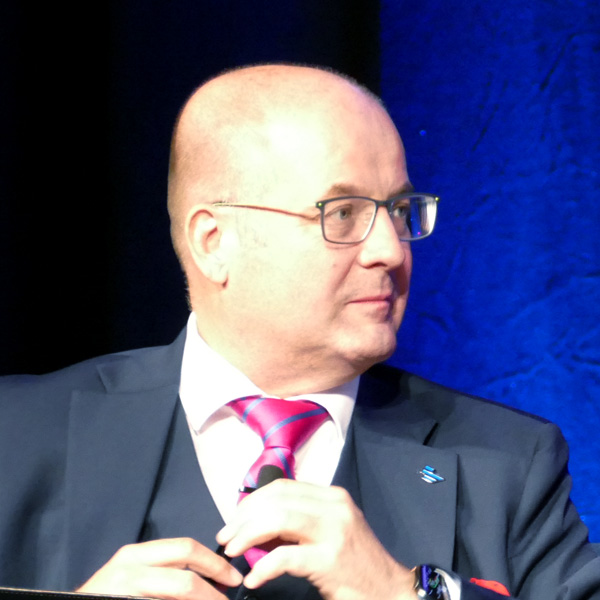PJM Announces Transitional Headroom Allocations
VALLEY FORGE, Pa. — PJM plans to allocate more than 2,000 MW of transmission headroom to generators that requested additional capacity interconnection rights (CIRs) under a transitional process as the RTO shifts to a new methodology for calculating CIRs for effective load carrying capability (ELCC) resources. (See FERC Approves Revisions to PJM’s ELCC Accreditation Model.)
Existing generators or those with signed ISAs may request higher accreditation through the transitional study process, which assigns a portion of available headroom on the grid to those resources. PJM’s Jonathan Kern said about 7,000 MW was eligible to participate in the studies, of which 2,073 MW was awarded, with the remaining 5,000 MW largely denied due to not being available for the upcoming delivery year. Those generators denied can receive access to headroom in future years once they are online.
“It’s just for this particular Base Residual Auction (BRA) that they didn’t achieve the particular milestones to participate,” he said.
The higher accreditation will be added onto resources’ CIRs when running calculations for the 2025/26 BRA and future auctions until the transitional period has ended. Should FERC grant PJM’s request to delay that auction — currently scheduled for next month — Kern said many of the figures calculated could change significantly, including headroom allocations. (See PJM Seeks to Delay Capacity Auctions Through 2028 Delivery Year.)
Most resources received either no increase in their accreditation or the full amount they asked for, with some receiving in between based on locational factors. Kern said there was no queue-based determination in the headroom allocation.
Stakeholders Seek Discussion on CIR Transfers
Denise Foster Cronin, of the East Kentucky Power Cooperative, and Tonja Wicks, of Elevate Renewable Energy, presented a problem statement and issue charge to open a discussion on streamlining the process of transferring CIRs from a deactivating generator to a replacement resource.
“Our motivation to bringing this forward is to add some certainty to something that is currently uncertain,” Cronin said.
The current rules allow CIRs to be used at a resource seeking to interconnect at the same site as the retiring generator or at a different point of interconnection. Transferring CIRs also requires a study of the grid upgrades that may be necessary to support the capacity offered by the new generator, part of the interconnection queue process.
The status quo process assumes studies can be completed relatively quickly, but the queue is backlogged as PJM transitions to a new process meant to complete studies quicker, potentially creating a “timing misalignment.” The problem statement says resources seeking to retire between 2023 and 2026 may expect a delay of four years before they’re able to transfer CIRs to new resources, affecting reliability and cost.
“Inefficiency in the CIR transfer process results in unnecessary additional cost to customers served by these generation capacity resources. Load serving entities may need to seek alternatives and may find inadequate hedges to mitigate market price exposure should CIR transfers not be efficiently executed,” the problem statement reads. “Also, the inefficiency could result in PJM needing to rely on [reliability-must-run] agreements and/or the transmission reinforcements to address reliability issues resulting from generation deactivation that otherwise would not be necessary if CIR transfers could be more efficient. These measures result in cost to load, and the allocation of such costs may extend beyond the zone in which the deactivating generation is located.”
The problem statement also calls for clarifying the resources the CIR transfer rules apply to, noting the status quo language refers to “generation capacity resources.” The document states that more explicit inclusion of energy storage or hybrid resources may be warranted.
The issue charge states that any changes to the current process for transferring CIRs to a replacement resource located at a different interconnection site would be considered out of scope. The sponsors’ presentation said the new standard interconnection process would not be affected.
Stakeholders asked questions on the implementation timeline and expressed concerns regarding possible queue jumping, generators being able to avoid grid upgrade cost allocations and any impact to generators already in the interconnection queue should resources receiving CIR transfers be studied first.
Reliability Requirement Study to Use New Software
PJM plans to use new software to conduct the 2023 Reserve Requirement Study (RRS), the annual process that resets the forecast pool requirement (FPR) and the installed reserve margin (IRM) for the following three delivery years and establishes an initial value for the fourth year out, 2027/28 in this case. The study will also set the winter weekly reserve target for the 2023/24 delivery year. (See “Stakeholders Endorse 2022 Reserve Requirement Study Results,” PJM PC/TEAC Briefs: Oct. 4, 2022.)
Past studies were conducted with the PRISM modeling software, but PJM’s Patricio Rocha Garrido said this year the software developed for the hourly loss-of-load modeling used for the ELCC study will be used in parallel with PRISM. Two separate sets of assumptions will be generated to correspond with the different approaches, and both sets of results will be presented to stakeholders after the study is done, with PJM planning to recommend one of the results for endorsement. PJM plans to ultimately shift to using the hourly loss-of-load modeling software by default in the future.
PJM will also be including data from the 2014 polar vortex based on experience gathered through the December 2022 winter storm. Previously, the polar vortex had been replaced with other data. The capacity benefit of ties will also be averaged over the past several years, rather than using annual data, due to value volatility.
The PC is slated to vote on the RRS approach at its June meeting.
Advocates Push for More Transmission Cost Details
State consumer advocates are seeking more insight into the development of cost estimates for supplemental transmission projects when they are presented to the Transmission Expansion Advisory Committee (TEAC). A presentation by the Consumer Advocates of PJM States (CAPS) said questions to transmission owners about their proposals have not yielded substantive information. (See “CAPS Pushes for More Transmission Upgrade Data,” PJM PC/TEAC Briefs: April 11, 2023.)
For the 22 projects presented at the April TEAC, the presentation said transmission owners were asked how they developed the estimated cost, to provide a breakdown of the project budget and if the relevant state utility commission would have planning oversight. None of the responses regarding project budgets provided a breakdown, instead pointing to processes for receive cost breakdowns after the work is done. None of the responses specifically addressed the question of oversight, the presentation said.
Exelon’s Alex Stern rejected CAPS’ complaint.
“We have enhanced the planning process, and the TOs are providing more transparency in a timely manner than anywhere else in the country,” he said. “We’re also providing the best, most accurate cost estimates that we can based on industry experience when we bring solutions to needs forward followed by cost updates posted on pjm.com quarterly from project inception to project completion.”
The estimates provided to TEAC can significantly change before a project goes to development and is completed based on state and local siting processes, Stern added.
Tom Schmidt of Buckeye Power said the nuances of each state’s oversight provisions can make providing a yes or no answer “very, very difficult,” giving Ohio as an example of a state where oversight depends on specific voltages and project length.
Transmission Expansion Advisory Committee
Data Center Growth in Ohio Contributing to Nearly $600 Million in Transmission Upgrades
American Electric Power presented about $579.5 million in transmission upgrades throughout Ohio to accommodate several new load interconnection requests. AEP’s Nicolas Koehler told the Transmission Expansion Advisory Committee (TEAC) that much of the load stems from a surge in plans to construct data centers, with new announcements over the past few months estimated to consume around 3,000 MW.
The bulk of the expense would be direct connection costs at $498 million, while the remaining $81.6 million are system upgrade costs.
Responding to stakeholders who questioned why the AEP projects weren’t following the same competitive process as the data center alley in Northern Virginia, PJM’s Dave Souder said the Virginia load growth has necessitated upgrades to the regional 500-kV transmission system. PJM has opened a third window to its 2022 Regional Transmission Expansion Plan (RTEP) to address “unprecedented growth” from data centers. (See “Load Forecast for Northern Virginia Data Centers Continues to Climb,” PJM PC/TEAC Briefs: Jan. 10, 2023.)
The largest portion of the Ohio work would involve significantly expanding the grid in the New Albany region and adding about a dozen new substations:
- The existing Corridor — the Conesville 345-kV line would have two new substations, Curleys and Bermuda, and it would be rerouted to tie into the existing Innovation substation, which would be upgraded to handle both the new 345-kV capability and its current 138-kV lines. The Curleys facility would serve an ultimate load of 968 MW and would come with a $55.2 million price tag, while the Bermuda substation would serve an ultimate demand of 337 MW and would cost around $60.3 million.
- The Corridor — the Jug Street 138-kV line would have four substations added along its run: Souder, which would serve a projected future load of around 100 MW at a $14.3 million cost estimate; Fiesta (up to 300 MW/$22.3 million); Horizon (200 MW/$11 million); and Badger (290 MW/$18 million).
- The Green Chapel — the Innovation 138-kV line would be cut and extended around 0.75 miles to connect to the new Tasjan substation, which would serve an ultimate load of 150 MW. The work would cost around $19 million.
- The Innovation — the Kirk 138-kV line would be cut with two single-circuit lines terminating around 0.35 miles at the new Jorden substation, which would serve a 270-MW load. The project would cost an estimated $12.5 million. A new line would be constructed from the Innovation facility to the Brie substation with around 1.75 miles of double-circuit 138-kV line. New equipment would be installed at the Brie site, addressing potential load drop and overload risks at a $10.8 million expense.
- The existing Innovation substation in the New Albany area would receive $53.7 million in upgrades to serve 247 MW of additional load. The proposed project includes cutting into the Corridor-Conesville 345-kV circuit and building a new 345-kV ring bus at the site.
Additional substations would be built in the area of Union County and Columbus:
- The Cyprus substation outside Columbus would be upgraded with 345-kV infrastructure, in addition to the existing 138-kV equipment, and cut into the Beatty-Bixby 345-kV line at a $46.9 expense.
- The proposal would build the new 138-kV and 345-kV Celtic substation in Union County to serve 461 MW of load at an estimated $60 million. The substation would cut into the Hayden-Hyatt 345-kV line and the Amlin-Hyatt 138-kV line and would also include a new 138-kV line to the existing Kileville line.
- The Beacon substation would be built for $40 million to supply an ultimate load of 328 MW in the Columbus area. The facility would cut into the Hayden-Roberts 345-kV circuit.
- The Jerome substation in Plain City would serve an initial load of 106 MW, which could grow as high as 203 MW at a $30 million price tag. The facility would connect to the proposed Celtic substation and the existing Hyatt-Amlin line via new 138-kV lines.
Several Generators Announce Deactivation
PJM’s Phil Yum presented an update on the status of deactivating generators, highlighting seven facilities that have recently requested to go offline.
The new deactivations include the 1,884-MW Homer City coal plant in Pennsylvania, the 1,282-MW Brandon Shores coal plant near Baltimore, and the 167-MW Vienna oil-fired generator in Maryland.
The PJM Board of Managers referenced the Homer City deactivation request in a May 1 letter responding to environmental groups that said the RTO’s analysis of future resource adequacy concerns overstated the issue.
“In performing the analysis discussed in this study, the PJM team made assumptions it believes are conservative, meaning that PJM did not try to overstate resource retirements … In fact, just recently, the largest Pennsylvania coal-fired generating plant, Homer City, announced its retirement. Homer City was not included in our retirement assumptions because the policy drivers underlying its retirement were not known at the time of the study,” the board wrote.
Changes to NJ Offshore Wind Transmission Add $128 Million
Several portions of the transmission planned to connect 6,400 MW of offshore wind to the PJM grid have been changed since the approval of the State Agreement Approach, leading to a $128 million increase in the expected project cost from $1.064 billion to $1.192 billion.
The scope of the work in the Jersey Central Power & Light (JCPL) zone has increased to include the removal of existing equipment to accommodate new lines for $17.47 million, while updated cost projections for previously expected JCPL work has increased by $31.71 million. Work in the Public Service Enterprise Group (PSEG) region has increased by $12.25 million, while a case correction in the PECO zone has reduced cost estimates by $5.6 million.
The expected construction cost for the Larrabee Collector Station, as well as procuring and preparing land adjacent to the site, has increased from $121.1 million to $193.3 million, with the new figures including costs that were explicitly excluded from the original estimate but have been determined to be required for the project.
Kern said additional work was identified after the approval of the project and will require the approval of the PJM Board of Managers. The New Jersey Board of Public Utilities is also aware of the changes.








